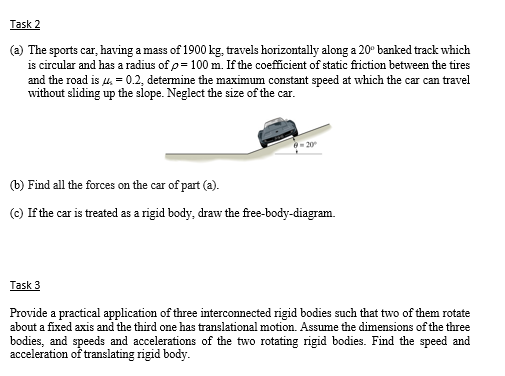Task 2 (a) The sports car, having a mass of 1900 kg. travels horizontally along a 20 banked track which is circular and has a radius of p= 100 m. If the coefficient of static friction between the tires and the road is u. = 0.2, determine the maximum constant speed at which the car can travel without sliding up the slope. Neglect the size of the car. (b) Find all the forces on the car of part (a). (c) If the car is treated as a rigid body, draw the free-body-diagram.
Task 2 (a) The sports car, having a mass of 1900 kg. travels horizontally along a 20 banked track which is circular and has a radius of p= 100 m. If the coefficient of static friction between the tires and the road is u. = 0.2, determine the maximum constant speed at which the car can travel without sliding up the slope. Neglect the size of the car. (b) Find all the forces on the car of part (a). (c) If the car is treated as a rigid body, draw the free-body-diagram.
International Edition---engineering Mechanics: Statics, 4th Edition
4th Edition
ISBN:9781305501607
Author:Andrew Pytel And Jaan Kiusalaas
Publisher:Andrew Pytel And Jaan Kiusalaas
Chapter7: Dry Friction
Section: Chapter Questions
Problem 7.24P: A uniform plank is supported by a fixed support at A and a drum at B that rotates clockwise. The...
Related questions
Question

Transcribed Image Text:Task 2
(a) The sports car, having a mass of 1900 kg, travels horizontally along a 20° banked track which
is circular and has a radius of p= 100 m. If the coefficient of static friction between the tires
and the road is 4, = 0.2, determine the maximum constant speed at which the car can travel
without sliding up the slope. Neglect the size of the car.
(b) Find all the forces on the car of part (a).
(c) If the car is treated as a rigid body, draw the free-body-diagram.
Task 3
Provide a practical application of three interconnected rigid bodies such that two of them rotate
about a fixed axis and the third one has translational motion. Assume the dimensions of the three
bodies, and speeds and accelerations of the two rotating rigid bodies. Find the speed and
acceleration of translating rigid body.
Expert Solution
This question has been solved!
Explore an expertly crafted, step-by-step solution for a thorough understanding of key concepts.
Step by step
Solved in 4 steps with 5 images

Knowledge Booster
Learn more about
Need a deep-dive on the concept behind this application? Look no further. Learn more about this topic, mechanical-engineering and related others by exploring similar questions and additional content below.Recommended textbooks for you

International Edition---engineering Mechanics: St…
Mechanical Engineering
ISBN:
9781305501607
Author:
Andrew Pytel And Jaan Kiusalaas
Publisher:
CENGAGE L

International Edition---engineering Mechanics: St…
Mechanical Engineering
ISBN:
9781305501607
Author:
Andrew Pytel And Jaan Kiusalaas
Publisher:
CENGAGE L